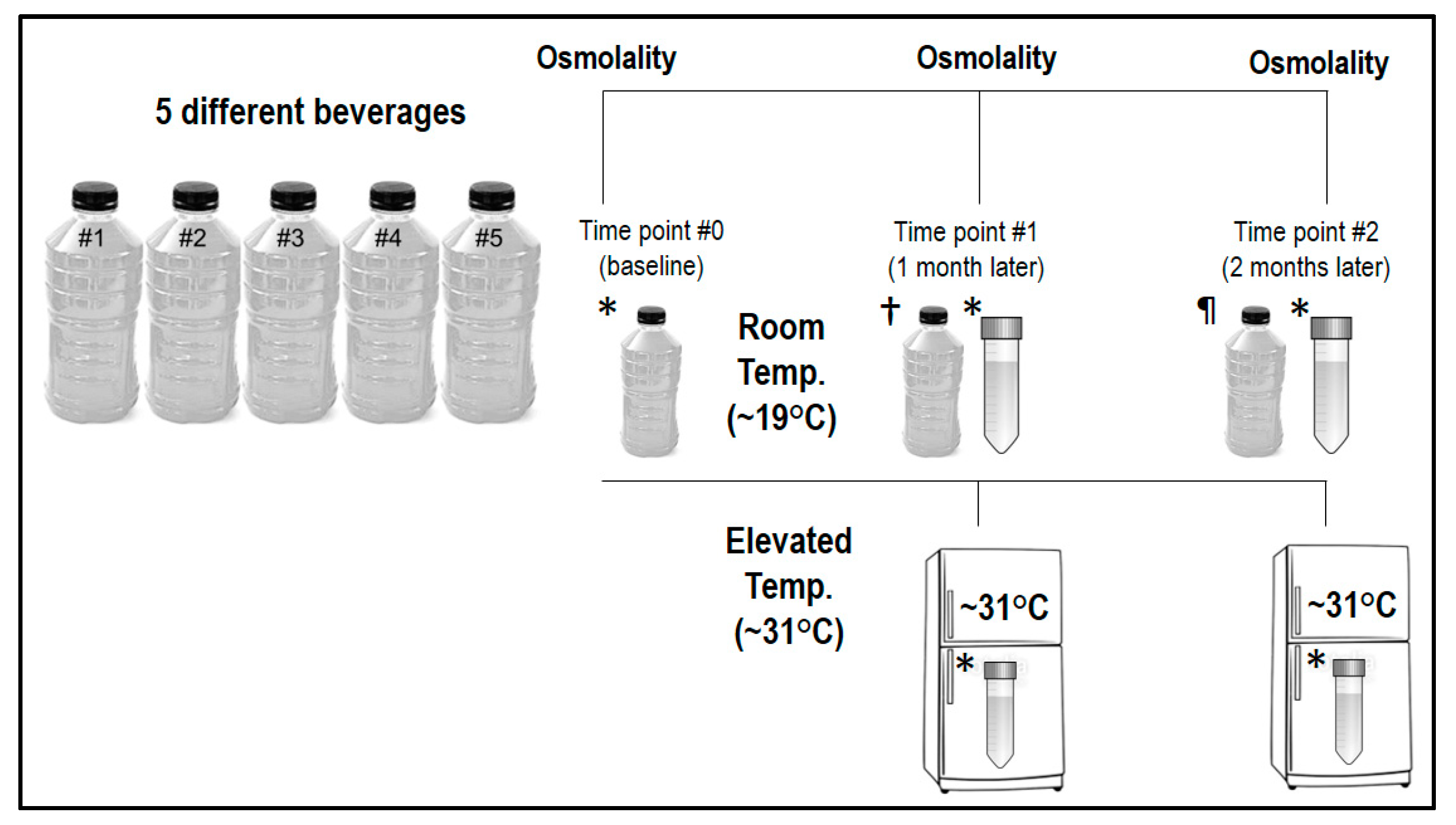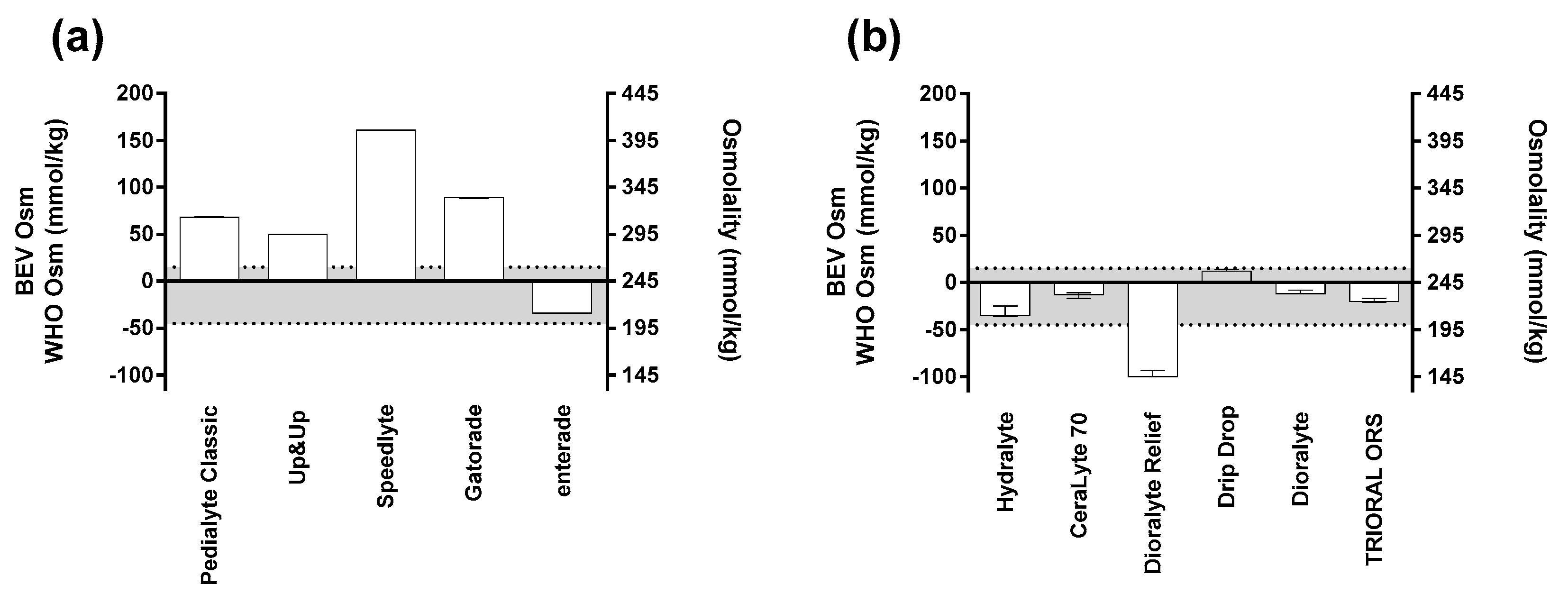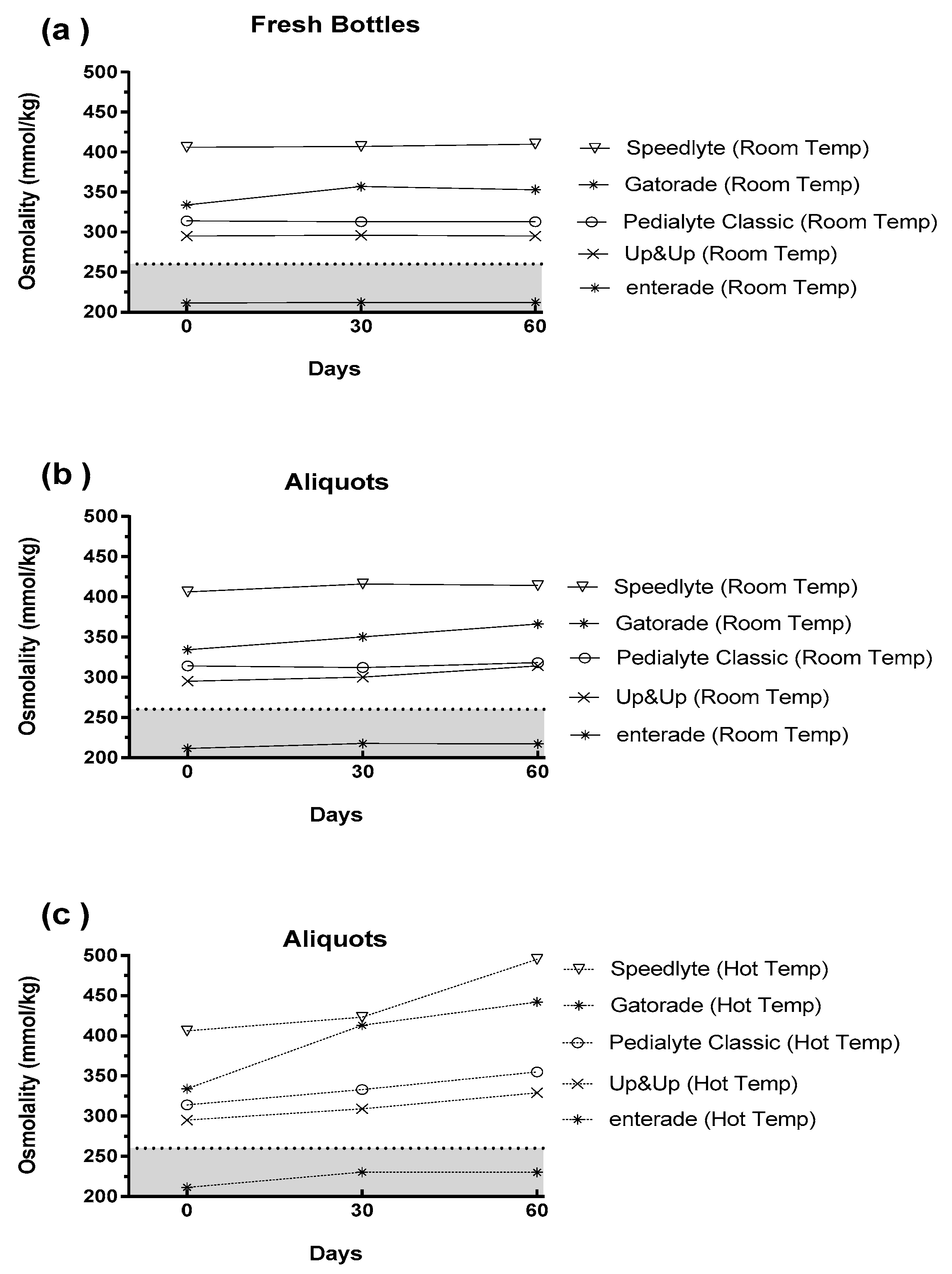Osmolality of Commercially Available Oral Rehydration Solutions: Impact of Brand, Storage Time, and Temperature
Abstract
1. Introduction
2. Materials and Methods
2.1. Drink and Drink Preparations
2.2. Study Overview
2.3. Osmometry
2.4. Water Content
2.5. Statistics and Data Presentation
3. Results
3.1. Pre-Mixed ORS Variability
3.2. Powdered ORS Variability
3.3. Impact of Time and Temperature
4. Discussion
Author Contributions
Funding
Acknowledgments
Conflicts of Interest
Appendix A
| Beverage Name | Ingredients |
|---|---|
| Pedialyte® Classic mixed (fruit flavor) | Water, Dextrose. Less than 2% of: Citric Acid, Natural & Artificial Flavor, Potassium Citrate, Salt, Sodium Citrate, Sucralose, Acesulfame Potassium, Zinc Gluconate, and Yellow 6. |
| Pediatric Oral Electrolyte Solution (fruit flavor) | Water, Dextrose, Citric Acid, Potassium Citrate, Sodium Chloride, Sodium Citrate, Acesulfame Potassium, Zinc Gluconate, Natural & Artificial Fruit Flavor, Sucralose, FD&C Yellow #6. |
| Speedlyte® (wild orange flavor) | Purified water; Less than 2% of: Dextrose, Sucrose, Liposomal Salt [Citrate, Chloride, Sodium, Potassium, Soy Lecithin, Xanthan Gum], Citric Acid, Sodium Benzoate, Stevia Extract, Monk Fruit, Beta Carotene, Rose Anthocyanin, Methylparaben, Sodium Metabisulfite, Natural Flavor. |
| enterade®AD ORS (orange flavor) | Water, Amino Acid Blend (L-Valine, L-Aspartic Acid, L-Serine, L-Isoleucine, L-Threonine, L-Lysine, L-Glycine, L-Tyrosine), sodium chloride, potassium citrate, trisodium citrate, natural flavor, magnesium citrate, calcium chloride, stevia. |
| Gatorade® (orange flavor) | Water, Sugar, Dextrose, Citric Acid, Salt, Sodium Citrate, Monopotassium Phosphate, Gum Arabic, Natural Flavor, Sucrose Acetate Isobutyrate, Glycerol Ester of Rosin, Yellow 6 |
References
- King, C.K.; Glass, R.; Bresee, J.S.; Duggan, C. Managing acute gastroenteritis among children: Oral rehydration, maintenance, and nutritional therapy. MMWR. Recomm. Rep. 2003, 52, 1–16. [Google Scholar] [PubMed]
- Kosek, M.; Bern, C.; Guerrant, R.L. The global burden of diarrhoeal disease, as estimated from studies published between 1992 and 2000. Bull. World Health Organ. 2003, 81, 197–204. [Google Scholar] [PubMed]
- Farthing, M.J. Oral rehydration: An evolving solution. J. Pediatr. Gastroenterol. Nutr. 2002, 34 (Suppl. 1), S64–67. [Google Scholar] [CrossRef] [PubMed]
- Nalin, D.R.; Cash, R.A. 50 years of oral rehydration therapy: The solution is still simple. Lancet 2018, 392, 536–538. [Google Scholar] [CrossRef]
- Hirschhorn, N. The treatment of acute diarrhea in children. An historical and physiological perspective. Am. J. Clin. Nutr. 1980, 33, 637–663. [Google Scholar] [CrossRef]
- Banks, M.R.; Farthing, M.J. Fluid and electrolyte transport in the small intestine. Curr. Opin. Gastroenterol. 2002, 18, 176–181. [Google Scholar] [CrossRef]
- Crane, R.K. Hypothesis for mechanism of intestinal active transport of sugars. Fed. Proc. 1962, 21, 891–895. [Google Scholar]
- Curran, P.F. Coupling between transport processes in intestine. Physiologist 1968, 11, 3–23. [Google Scholar]
- Fordtran, J.S.; Rector, F.C., Jr.; Carter, N.W. The mechanisms of sodium absorption in the human small intestine. J. Clin. Invest. 1968, 47, 884–900. [Google Scholar] [CrossRef]
- Schultz, S.G.; Zalusky, R. Ion transport in isolated rabbit ileum. I. Short-circuit current and Na fluxes. J. Gen. Physiol. 1964, 47, 567–584. [Google Scholar] [CrossRef]
- Schultz, S.G.; Zalusky, R. Ion transport in isolated rabbit ileum. II. The interaction between active sodium and active sugar transport. J. Gen. Physiol. 1964, 47, 1043–1059. [Google Scholar] [CrossRef] [PubMed]
- Atia, A.N.; Buchman, A.L. Oral rehydration solutions in non-cholera diarrhea: A review. Am. J. Gastroenterol. 2009, 104, 2596–2604, quiz 2605. [Google Scholar] [CrossRef] [PubMed]
- Impact of glycine-containing ORS solutions on stool output and duration of diarrhoea: A meta-analysis of seven clinical trials. The International Study Group on Improved ORS. Bull. World Health Organ. 1991, 69, 541–548.
- Duggan, C.; Fontaine, O.; Pierce, N.F.; Glass, R.I.; Mahalanabis, D.; Alam, N.H.; Bhan, M.K.; Santosham, M. Scientific rationale for a change in the composition of oral rehydration solution. JAMA 2004, 291, 2628–2631. [Google Scholar] [CrossRef] [PubMed]
- WHO. Reduced Osmolarity Oral Rehydration Salts (ORS) Formulation: A Report from a Meeting of Expert Jointly Organised by UNICEF and WHO: UNICEF House, New York, USA, July 18, 2001. Available online: https://apps.who.int/iris/handle/10665/67322 (accessed on 7 April 2019).
- Leiper, J.B. Fate of ingested fluids: Factors affecting gastric emptying and intestinal absorption of beverages in humans. Nutr. Rev. 2015, 73 Suppl. 2, 57–72. [Google Scholar] [CrossRef]
- Izgu, E.; Baykara, T. The solid state stability of oral rehydration salts. J. Clin. Hosp. Pharm. 1981, 6, 135–144. [Google Scholar] [CrossRef] [PubMed]
- WHO. Climate Change and Human Health: Risk and Responses; WHO: Geneva, Switzerland, 2003. [Google Scholar]
- Mora, C.; Dousset, B.; Caldwell, I.R.; Powell, F.E.; Geronimo, R.C.; Bielecki, C.R.; Counsell, C.W.; Dietrich, B.S.; Johnston, E.T.; Louis, L.V.; et al. Global risk of deadly heat. Nat. Clim. Chang. 2017, 7, 501. [Google Scholar] [CrossRef]
- Goldberg, R.N.; Tewari, Y.B.; Ahluwalia, J.C. Thermodynamics of the hydrolysis of sucrose. J. Bio. Chem. 1989, 264, 9901–9904. [Google Scholar]
- Pantenburg, B.; Ochoa, T.J.; Ecker, L.; Ruiz, J. Use of Commercially Available Oral Rehydration Solutions in Lima, Peru. Am. J. Trop. Med. Hyg. 2012, 86, 922–924. [Google Scholar] [CrossRef]
- Rao, S.S.; Summers, R.W.; Rao, G.R.; Ramana, S.; Devi, U.; Zimmerman, B.; Pratap, B.C. Oral rehydration for viral gastroenteritis in adults: A randomized, controlled trial of 3 solutions. JPEN J. Parenter. Enteral. Nutr. 2006, 30, 433–439. [Google Scholar] [CrossRef]
- Sollanek, K.J.; Kenefick, R.W.; Cheuvront, S.N. Importance of sample volume to the measurement and interpretation of plasma osmolality. J. Clin. Lab. Anal. 2019, 33, e22727. [Google Scholar] [CrossRef] [PubMed]
- Cheuvront, S.N.; Kenefick, R.W.; Heavens, K.R.; Spitz, M.G. A comparison of whole blood and plasma osmolality and osmolarity. J. Clin. Lab. Anal. 2014, 28, 368–373. [Google Scholar] [CrossRef]
- Bohnen, N.; Terwel, D.; Markerink, M.; Ten Haaf, J.A.; Jolles, J. Pitfalls in the measurement of plasma osmolality pertinent to research in vasopressin and water metabolism. Clin. Chem. 1992, 38, 2278–2280. [Google Scholar]
- Plaisier, A.; Maingay-de Groof, F.; Mast-Harwig, R.; Kalkman, P.M.; Wulkan, R.W.; Verwers, R.; Neele, M.; Hop, W.C.; Groeneweg, M. Plasma water as a diagnostic tool in the assessment of dehydration in children with acute gastroenteritis. Eur. J. Pediatr. 2010, 169, 883–886. [Google Scholar] [CrossRef] [PubMed]
- Eisenman, A.J.; Mackenzie, L.B.; Peters, J.P. Protein and water of serum and cells of human blood, with a note on the measurement of red blood cell volume. J. Biol. Chem. 1936, 116, 33–45. [Google Scholar]
- Al-Ramahi, R.; Zaid, A.; Hussein, A.; Yaseen, A.; Abdallah, K.; Odeh, M. Evaluation of mothers’ practice in the treatment of children diarrhea and measurement of the osmolality and PH of some oral rehydration solutions and carbonated beverages. An-Najah Univ. J. Res. (N. Sc.) 2016, 30, 269–282. [Google Scholar]
- Mettler, S.; Rusch, C.; Colombani, P.C. Osmolality and pH of sport and other drinks available in Switzerland. Schweiz. Z. Med. Traumatol. 2006, 54, 92. [Google Scholar]
- Wesley, J.F. Osmolality—A novel and sensitive tool for detection of tampering of beverages adulterated with ethanol, γ-butyrolactone, and 1,4-butanediol, and for detection of dilution-tampered demerol syringes. Microgram J. 2003, 8–17. [Google Scholar]
- Clarke, M.A. Technological value of sucrose in food products. In Sucrose: Properties and Applications; Mathlouthi, M., Reiser, P., Eds.; Springer: Boston, MA, USA, 1995. [Google Scholar]
- Hofman, D.L.; van Buul, V.J.; Brouns, F.J. Nutrition, Health, and Regulatory Aspects of Digestible Maltodextrins. Crit. Rev. Food Sci. Nutr. 2016, 56, 2091–2100. [Google Scholar] [CrossRef] [PubMed]
- Nicastro, A.; Barbarini, A.L.; Souss, G.M. Liposomal Rehydration Salt Formulation and Associated Method of Use. U.S. Patent 15/797,031, 22 February 2018. [Google Scholar]
- Yin, L.; Gupta, R.; Vaught, L.; Grosche, A.; Okunieff, P.; Vidyasagar, S. An amino acid-based oral rehydration solution (AA-ORS) enhanced intestinal epithelial proliferation in mice exposed to radiation. Sci. Rep. 2016, 6, 37220. [Google Scholar] [CrossRef] [PubMed]
- Yin, L.; Vijaygopal, P.; MacGregor, G.G.; Menon, R.; Ranganathan, P.; Prabhakaran, S.; Zhang, L.; Zhang, M.; Binder, H.J.; Okunieff, P.; et al. Glucose stimulates calcium-activated chloride secretion in small intestinal cells. Am. J. Physiol. Cell Physiol. 2014, 306, C687–C696. [Google Scholar] [CrossRef] [PubMed]
- Yin, L.; Menon, R.; Gupta, R.; Vaught, L.; Okunieff, P.; Vidyasagar, S. Glucose enhances rotavirus enterotoxin-induced intestinal chloride secretion. Pflugers Arch. 2017, 469, 1093–1105. [Google Scholar] [CrossRef] [PubMed]
- Hodges, K.; Gill, R. Infectious diarrhea: Cellular and molecular mechanisms. Gut Microbes 2010, 1, 4–21. [Google Scholar] [CrossRef] [PubMed]



© 2019 by the authors. Licensee MDPI, Basel, Switzerland. This article is an open access article distributed under the terms and conditions of the Creative Commons Attribution (CC BY) license (http://creativecommons.org/licenses/by/4.0/).
Share and Cite
Sollanek, K.J.; Kenefick, R.W.; Cheuvront, S.N. Osmolality of Commercially Available Oral Rehydration Solutions: Impact of Brand, Storage Time, and Temperature. Nutrients 2019, 11, 1485. https://doi.org/10.3390/nu11071485
Sollanek KJ, Kenefick RW, Cheuvront SN. Osmolality of Commercially Available Oral Rehydration Solutions: Impact of Brand, Storage Time, and Temperature. Nutrients. 2019; 11(7):1485. https://doi.org/10.3390/nu11071485
Chicago/Turabian StyleSollanek, Kurt J., Robert W. Kenefick, and Samuel N. Cheuvront. 2019. "Osmolality of Commercially Available Oral Rehydration Solutions: Impact of Brand, Storage Time, and Temperature" Nutrients 11, no. 7: 1485. https://doi.org/10.3390/nu11071485
APA StyleSollanek, K. J., Kenefick, R. W., & Cheuvront, S. N. (2019). Osmolality of Commercially Available Oral Rehydration Solutions: Impact of Brand, Storage Time, and Temperature. Nutrients, 11(7), 1485. https://doi.org/10.3390/nu11071485





